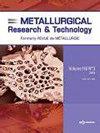Research on an external adjustment method for RPECT roll profiles based on the segmented cooling principle
IF 1.1
4区 材料科学
Q3 METALLURGY & METALLURGICAL ENGINEERING
引用次数: 1
Abstract
Roll profile electromagnetic control technology (RPECT) is a new strip flatness control technology that changes roll gap shape by controlling the roll profiles of electromagnetic control rolls (ECRs). To address the randomness of the flatness defect locations, this paper proposes an external adjustment method for RPECT roll profiles based on the segmented cooling principle. Based on the layout of the cooling areas and electromagnetic sticks, an electromagnetic-thermal-structural coupled model is established to analyse roll profile variations. The results show that symmetrically changing the cooling intensities of the different cooling areas can increase or decrease the roll crown of the ECR, while asymmetrically changing the cooling intensities of the different cooling areas can change the position of the maximum bulging point of the ECR. Variations in the component cooling ratio coefficient impact the effects of different cooling strategies, which needs to be considered when selecting the cooling strategy configuration scheme. Compared the maximum bulging values, radial temperature gradients and axial temperature gradients of different electromagnetic stick (ES) structures, the regulation law reverses when the length of the ES is too small, and the variation of the law is very small. Therefore, different ES structures have different segmented cooling regulation characteristics.基于分段冷却原理的RPECT辊型外校方法研究
辊型电磁控制技术是通过控制电磁控制辊的辊型来改变辊缝形状的一种新型板形控制技术。针对rpct轧辊板形缺陷位置的随机性,提出了一种基于分段冷却原理的轧辊型线外部调整方法。基于冷却区和电磁棒的布置,建立了分析辊型变化的电磁-热-结构耦合模型。结果表明:对称改变不同冷却区域的冷却强度可以增大或减小ECR的辊凸度,而不对称改变不同冷却区域的冷却强度可以改变ECR最大胀形点的位置。部件冷却比系数的变化会影响不同冷却策略的效果,在选择冷却策略配置方案时需要考虑到这一点。对比不同电磁棒结构的最大胀形值、径向温度梯度和轴向温度梯度,发现当电磁棒长度过小时,调节规律相反,且变化很小。因此,不同ES结构具有不同的分段冷却调节特性。
本文章由计算机程序翻译,如有差异,请以英文原文为准。
求助全文
约1分钟内获得全文
求助全文
来源期刊

Metallurgical Research & Technology
METALLURGY & METALLURGICAL ENGINEERING-
CiteScore
1.70
自引率
9.10%
发文量
65
审稿时长
4.4 months
期刊介绍:
Metallurgical Research and Technology (MRT) is a peer-reviewed bi-monthly journal publishing original high-quality research papers in areas ranging from process metallurgy to metal product properties and applications of ferrous and non-ferrous metals and alloys, including light-metals. It covers also the materials involved in the metal processing as ores, refractories and slags.
The journal is listed in the citation index Web of Science and has an Impact Factor.
It is highly concerned by the technological innovation as a support of the metallurgical industry at a time when it has to tackle severe challenges like energy, raw materials, sustainability, environment... Strengthening and enhancing the dialogue between science and industry is at the heart of the scope of MRT. This is why it welcomes manuscripts focusing on industrial practice, as well as basic metallurgical knowledge or review articles.
 求助内容:
求助内容: 应助结果提醒方式:
应助结果提醒方式:


